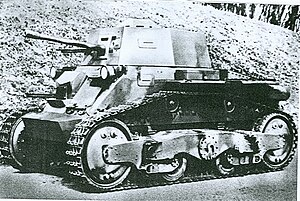Unkarissa syntynyt autoinsinööri kehitti maineensa innovatiivisena keksijänä ennen
muuttoaan Britanniaan maailmansotien välisenä aikana. Englannissa hänen työnsä
oli pääasiassa suunnitella amfibioajoneuvoja, maasto-autoja, sekä sotilasajoneuvoja.
Vuosien 1928 - 1933 aikana Straussler rakensi ja patentoi useita kelluntavälineitä, myös kokoontaitettavia. Helmikuussa 1933 hänestä tuli Britannian kansalainen.
Hän työskenteli koko 1930 luvun aika Alvin autojen, Vickers-Armstrong yhtiön sekä Unkarin yritysten eri projekteissa.
...sekä Alvis Straussler AC3 joiden prototyypit rakennettiin omassa Straussler
Mechanisatio yhtiössä ja sarjavalmistus aloitettiin uudessa Alvis-Straussler yhteis-yrityksessä joka perustettiin heinäkuussa 1936
Straussler paransi AC2 mallin suunnitelmia, ja 39M rakennettiin unkarissa nimellä
Csapa.

Lisäksi rakennettiin kevyt tankki V4 joka jäi vain karkeaksi protyypiksi.
Eräs Alvin Straussler malli oli Bomb Trolley, joita rakennettiin 10.000 kpl RAF :lle.
Toinen tunnettu versio oli Garner-Straussler G3 maasto kuorma-auto. Werhmacth
käytti näitä kevyen tykistön veto-traktoreina ww-2 aikana.

Straussler V-4
Strausslerin työ Vickers-Armstrong yhtiölle sisälti varusteiden suunnittelun tankeille
ja näiden suunnitteluratkaisuiden osalta joita hän laati, pyrki olemaan innovatiivinen
tosin joskus käytännöllisyyden kustannuksella.


Kokeilut joita Britis War Office teki osoittivat ratkaisujen toimivan ja myös sen että takki jossa oli perämoottori pystyi uimaan kohtalaisesti.
Strausslerille myönnettiin lupa kokeilla Tetrach panssarivaunua joka oli varustettu
laivan potkurilla...
...jota pyöritti vaunun oma moottori erillisen kytkimen ja voiman siirto akselin kautta,
ja veto voitiin kytkeä pois ja päälle tarpeen mukaan.
Tämä käyttövoiman johdosta syntyi nimitys tai termi DD eli Dublex Drive, jota nimeä alettiin käyttää takana olevalla potkurilla varustetuille panssarivaunuille.
-----------------------------------------------------------------------------------------------------------------
Nicholas Straussler (in Hungarian: Straussler Miklós) (1891–1966) was an engineer mainly remembered for devising the flotation system used by Allied amphibious DD tanks during World War II.

Born in Hungary, he developed a reputation as an innovative automotive engineer before moving to Britain during the interwar period. His work was mainly to do with amphibious, off-road and military vehicles.
Between 1928 and 1933, Straussler ran Folding Boats and Structures Ltd and patented a number of flotation devices, including collapsible ones.
In February 1933, he became a British citizen.
Throughout the 1930s, he worked with Alvis Cars, Vickers-Armstrong and Hungarian companies on a variety of projects. His work for Alvis involved designing armoured cars such as the Alvis Straussler AC2 and the Alvis Straussler AC3. The prototypes were built by his own company Straussler Mechanisation Ltd. and the production vehicles by a new joint company, Alvis-Straussler. that was formed in July, 1936.
Do you know this familiar car
He later improved the AC2 design....
and it was built in Hungary as the 39M Csaba.
A tank, the Light Tank V4, was built in Hungary to his design but never got past the prototype stage. One of his designs that did see widespread use was the Alvis Straussler Bomb Trolley.
Around 10,000 were made for the Royal Air Force to transport bombs, mainly within airfields. Each carried four 250 pound bombs, although large versions were later produced.

Another project he was involved with was the Garner-Straussler G.3, a 4×4, off-road truck that was later used in small numbers as an artillery tractor by the Germans during World War 2.
Straussler's work for Vickers-Armstrong, included designing accessories for tanks. The engineering solutions he produced tended to be innovative, though sometimes at the expense of practicability.
He used his flotation device experience to develop collapsible floats for Vickers-Armstrong that could be used to construct a pontoon bridge or could be mounted on either side of a light tank to make it amphibious. Trials conducted by the British War Office showed that such a tank, propelled by an outboard motor, 'swam' reasonably well.
The system was unsatisfactory, mainly because of the unwieldy bulk of floats that were big enough to float a tank (each was roughly the size of the tank itself). In practice, there would be severe difficulties in transporting by truck enough floats, even collapsed ones, to move a large unit of tanks across a body of water.

Also, such floats made a tank too wide to launch itself into the sea from an off-shore landing craft, making their use in amphibious landings impractical.
Straussler was allocated a Tetrarch tank for experimentation and it was fitted with a screen together with a marine propeller that took its drive from the tank's engine. The two forms of propulsion - propeller and tracks - gave rise to the term Duplex Drive ("DD") for such tanks.
The first trial of the DD Tetrarch took place in June 1941 in Brent Reservoir (also known as Hendon Reservoir) in North London in front of General Alan Brooke, who was an early enthusiast for the idea. Coincidentally, this was also where trials of a floating version of the British Mark IX tank took place in November 1918.
Satisfactory sea trials of the Tetrarch took place near Hayling Island and the go-ahead was given to develop a production DD tank based on the Valentine tank. This version never saw combat and was mainly used to train crews who subsequently served in the DD versions of the M4 Sherman, one of a number of unusually modified, special purpose tanks (Hobart's Funnies) that saw action during and after D-Day.


















A very clever man!
VastaaPoistaGood morning, unknown ploki friend.
PoistaKlock 06.05
Thank you for your comments.
Its very luck so happens, I found these Straussler / Csapa pages.
This was a surprise me too ...
I think this is also the last big surprise that I can make and present to you
The rest might be more well-known...